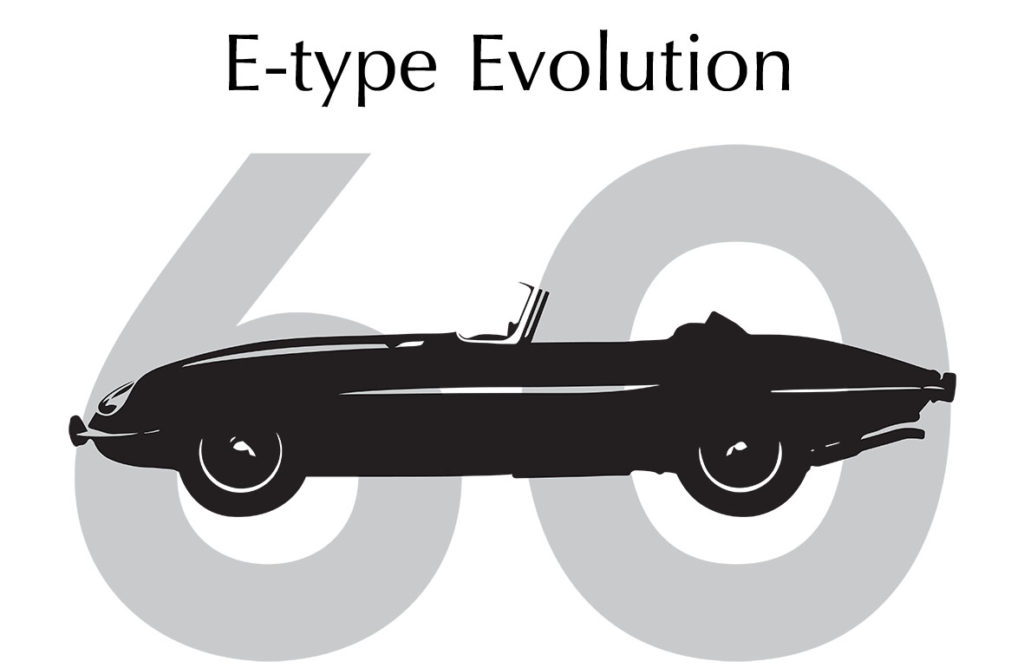

15th March 1961, Parc des Eaux Vives, Geneva
Introduction
March 2021 marked the 60th anniversary of the launch of the E-type. To commemorate this we set up the exhibition ‘E-Type Evolution’ at the British Motor Museum at Gaydon, from 1 March 2021 to 28 June 2021. It told the story of the evolution of the E-Type from the racing C and D-types of the 1950s, to its launch at Geneva on 15 March 1961, finishing with a couple of successful Racing V12s from the 1970s.
Geneva Motor Show, 1961
The story of the launch of the E-Type has gone into Jaguar Legend.
By 1961 Bob Berry was Public Relations Manager and together with Bill Rankin were in charge of PR for the launch of the E-type.
“SENSATIONAL is the word for this Coventry cat… The car comes up to, and exceeds, all our expectations.” Road and Track, September 1961
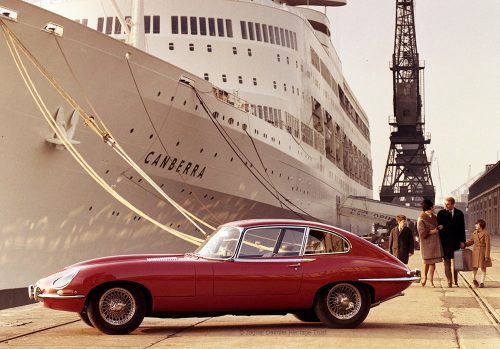
On 15 March 1961, the Gunmetal Grey Jaguar E-type fixed-head coupe, registered 9600 HP, was unveiled to the press at the Parc des Eaux Vives in Geneva.
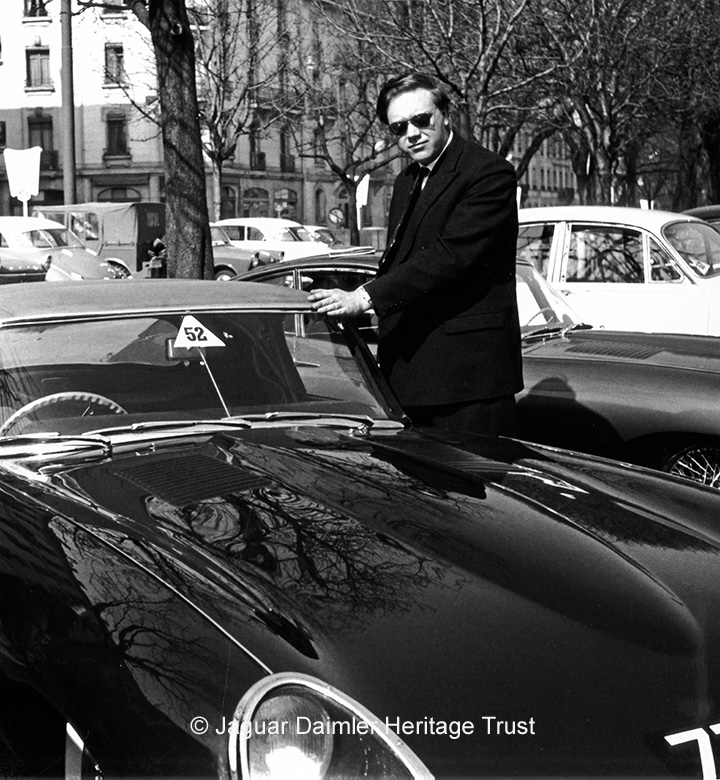
9600 HP left Browns Lane for the trip to Geneva later than originally planned. Rather than transporting it, Berry drove it all the way from Coventry to Geneva, catching the midnight ferry from Dover. Being delayed by fog between Calais and Reims he arrived with 20 minutes to spare after the drive of his life, “good God, Berry, I thought you weren’t going to get here” Sir William Lyons said, as the car was quickly getting wiped clean for the big reveal.
Berry recalled, “it was the only car I actually drove flat out from one end to the other of a journey, simply to get there on time. It was the most incredible journey and I’ve never forgotten it.”
Berry then proceeded to give journalists demonstration runs up a nearby hillclimb course, but demand was so high that Lyons phoned the factory and told Norman Dewis, then Jaguar’s Test and Development Engineer, to drive the first E-type Roadster, 77 RW, to Geneva.
Dewis famously drove 77 RW from Coventry to Geneva in a dramatic 17 hour overnight run, arriving the following morning, just in time to wipe the car down ready for the press. Here’s a video of him regaling you with the tale of what has become known as his ‘Mad Dash to Geneva’:
Structural Evolution from C-type to E-type
The Exhibition explains how the structure of the E-Type evolved from Jaguar’s racing history.
The XK120, XK140 and XK150 were all built on a steel chassis with a separate body. Racing driver Leslie Johnson entered an XK120 for the 1950 Le Mans 24 hour race, retiring after 22 hours. This showed that the XK engine and running gear were essentially reliable, but the car needed more speed and less weight for it to be competitive.
Bill Heynes’ solution was to replace the heavy steel chassis with a lighter, tubular steel, spaceframe which would be clothed with an aerodynamic body designed by Malcom Sayer.
The E-type structure was completely unlike any of its predecessors weighing in at 225 kg less than the XK150 it replaced
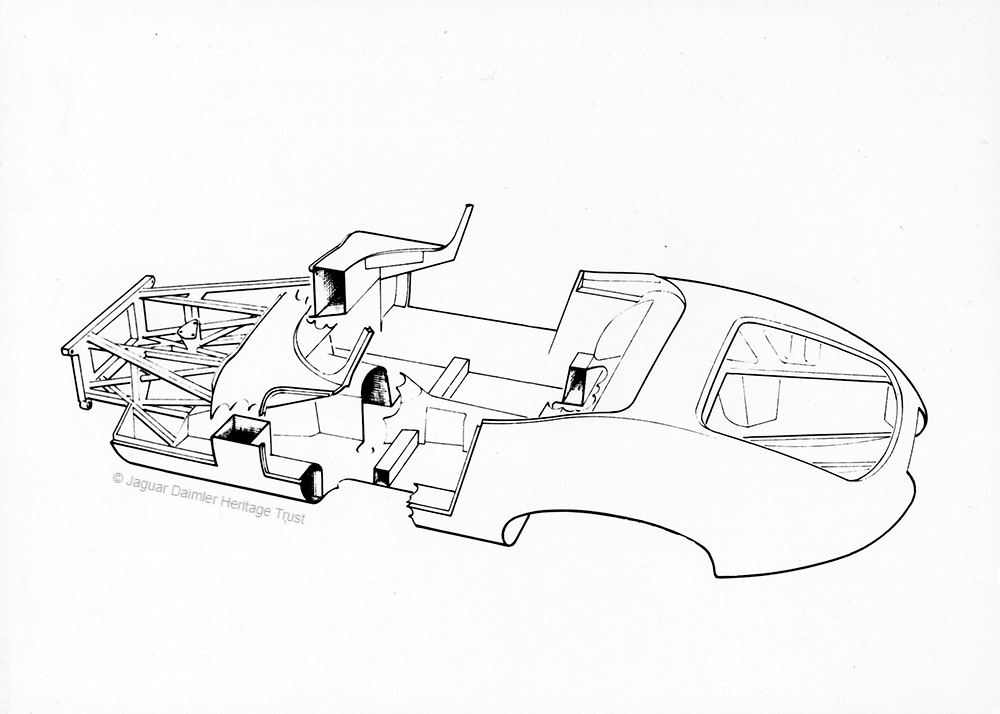
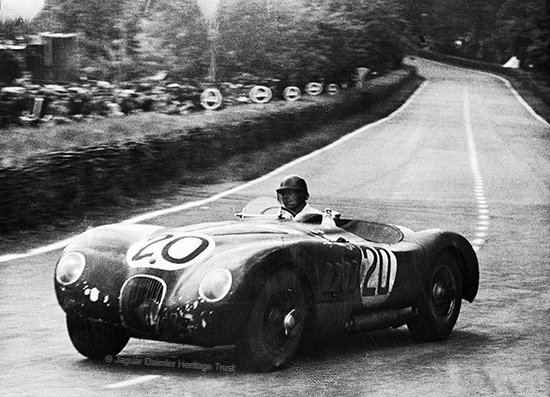
When Jaguar went to Le Mans in 1951 with a C-Type, Peter Walker paired with Peter Whitehead would go on to win the race on their first attempt, just six weeks after completion.
It should be noted, during the practice session, Walker completed a best lap at 4 min and 50 sec in the dark, at an average speed of 104 mph – no other driver, including Stirling Moss, could get below 5 min.
The D-type was an evolution of this with a central body tub with very strong front and rear bulkheads replacing the C-type’s spaceframe. A front subframe carried the engine, suspension and steering and the rear suspension and axle were fixed to the rear bulkhead. Bodywork at the front and rear were hinged ‘clamshells’, again designed and refined by Malcom Sayer.
The D-type’s central tub became a half monocoque encapsulating the passenger compartment and the whole rear of the car, with the new Independent Rear Suspension (IRS) fixed to the bodyshell on rubber mountings. As with the D-type the engine, suspension and steering were all fixed to the front spaceframe.
The structure of prototypes E1A, E2A and then the production E-Type were further evolutions of this.
1960’s Icon
The E-Type became an icon of the 1960s, while not affordable for ‘everyman’ it was far more attainable than an Aston Martin (at twice the price) or a Ferrari (at three times the price).
It would seem that anybody who was anybody bought an E-Type or posed with one. Some of them even collected their car from the factory at Browns Lane, providing Jaguar with a number of excellent PR opportunities.
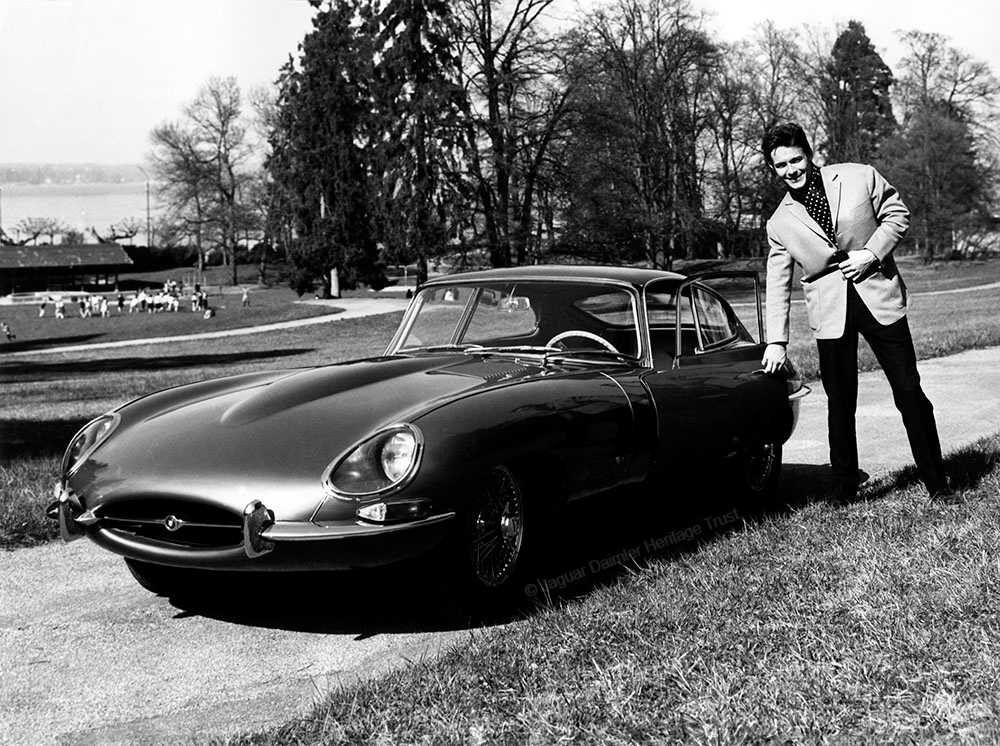
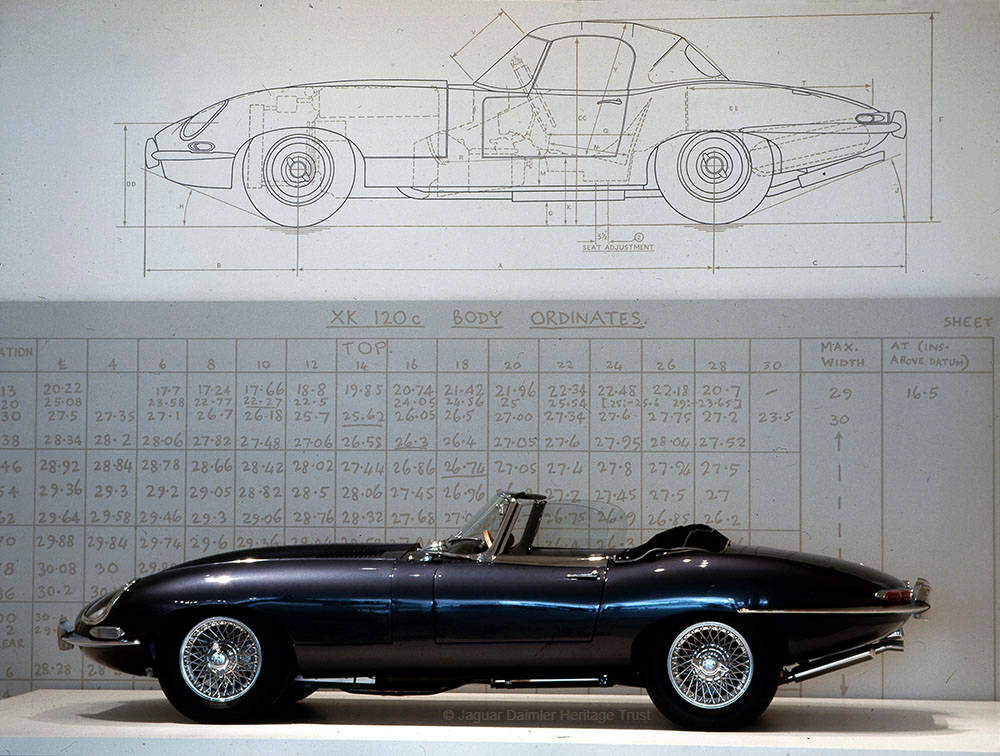
The Museum of Modern Art in New York added an E-type as a permanent exhibit in 1996
Ranges of E-types
The E-Type itself went on to evolve from its launch in 1961 to the end of production in 1974. Some of the changes were relatively minor like moving the bonnet locks from external to internal and installing dropped floor panels to increase legroom, but there were some major changes.
In 1964 Jaguar launched the 4.2 litre version of the XK engine in the E-Type, changing the gearbox from the old fashioned Moss box to one designed and built in-house. Brakes were upgraded and the seats were greatly improved.
For many people the 4.2 litre version of the Series 1 E-Type is the most desirable car – it retains the purity of the original car with its faired in headlights, the 4.2 litre engine and Jaguar all-synchromesh gearbox made the car more fun to drive, the better brakes improve stopping power and the improved seating made it more comfortable for long distance driving. All of these upgrades made it a more refined, more civilised car.
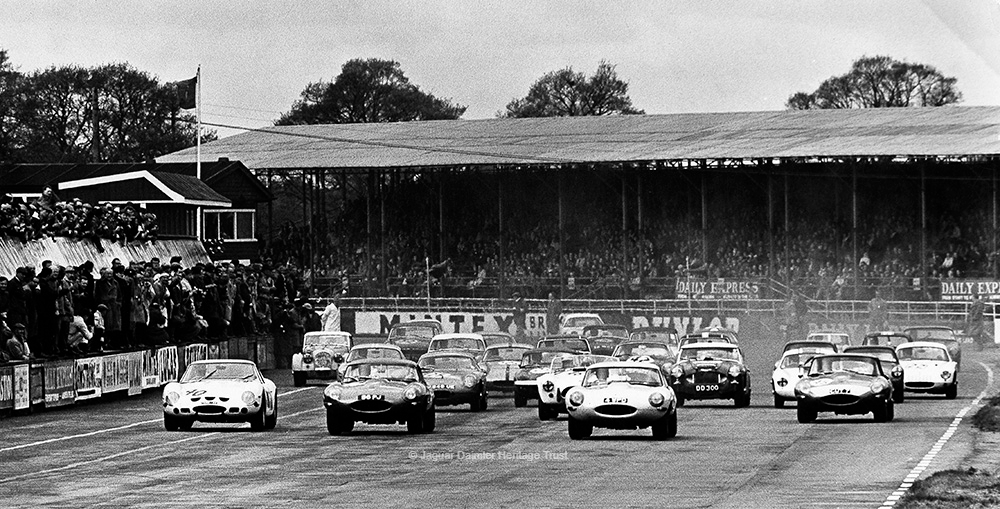
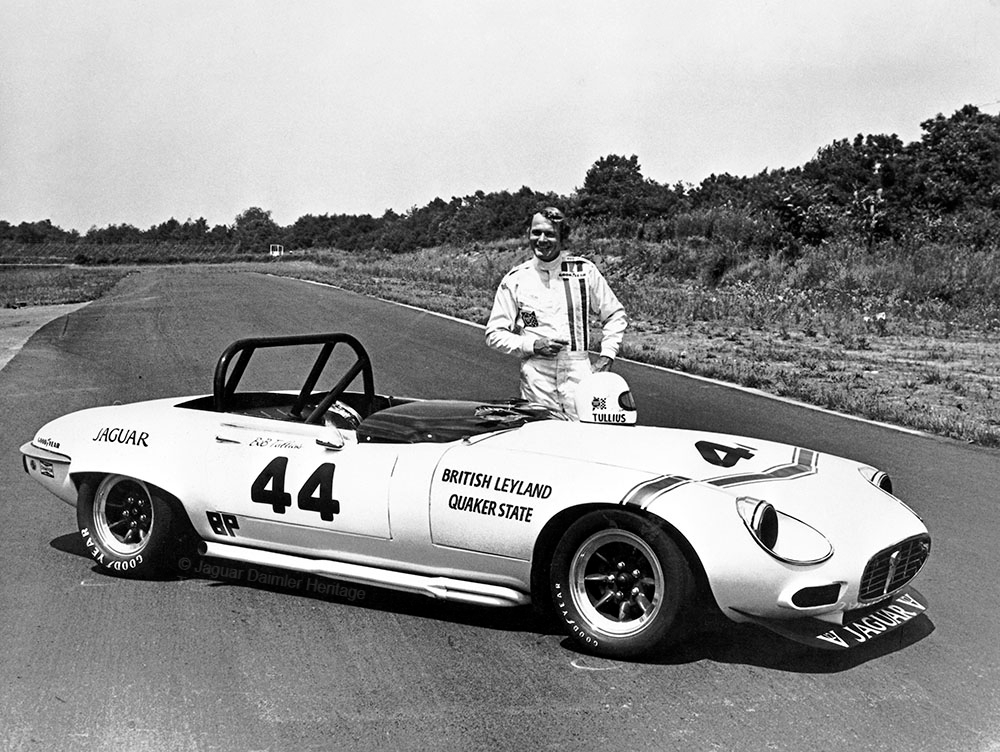
Competition E-types
Although the E-type was designed for everyday use it had racing in its DNA and was very successful throughout the 1960s and 1970s.
In April 1961, only one month after the launch at Geneva, three standard E-Types were raced at Oulton Park with Graham Hill taking its first win.
Our own Group 44 V12 E-Type was raced in the USA for Bob Tullius’ Group 44 team and after a fairly successful season in 1974, they won the SCCA Group B championship in 1975.
Between 1963 and 1964 Jaguar produced twelve Lightweight E-types to compete in serious racing. Two of these were Peter Lumsden‘s 49 FXN and Peter Lindner‘s 4868 WK, the well-known Lindner-Nöcker
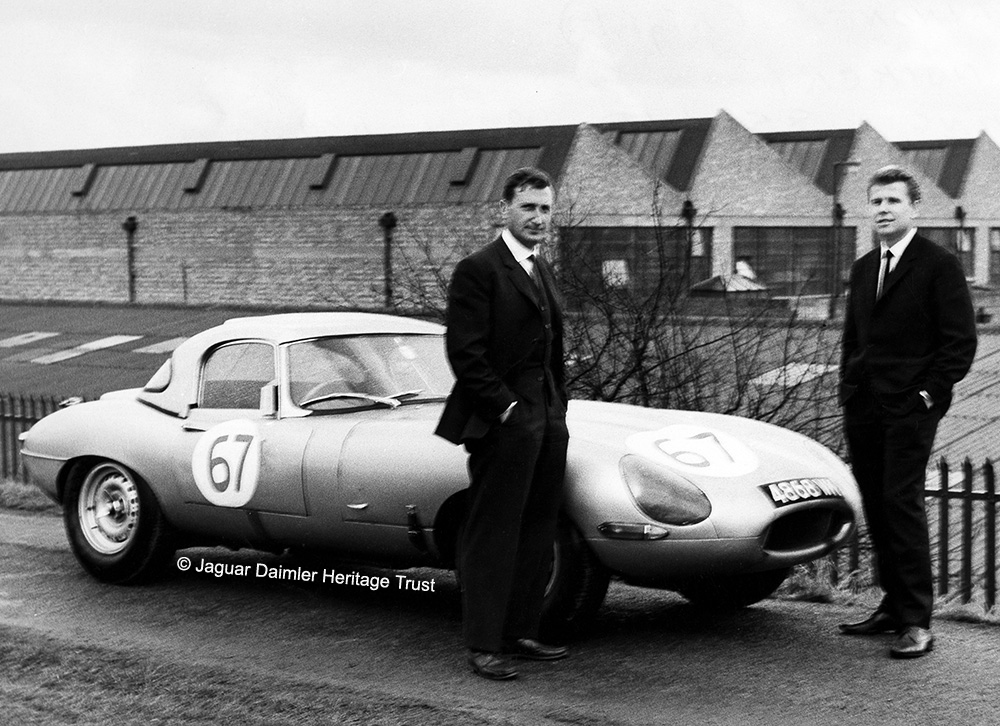
For the exhibition we created the below display panels:
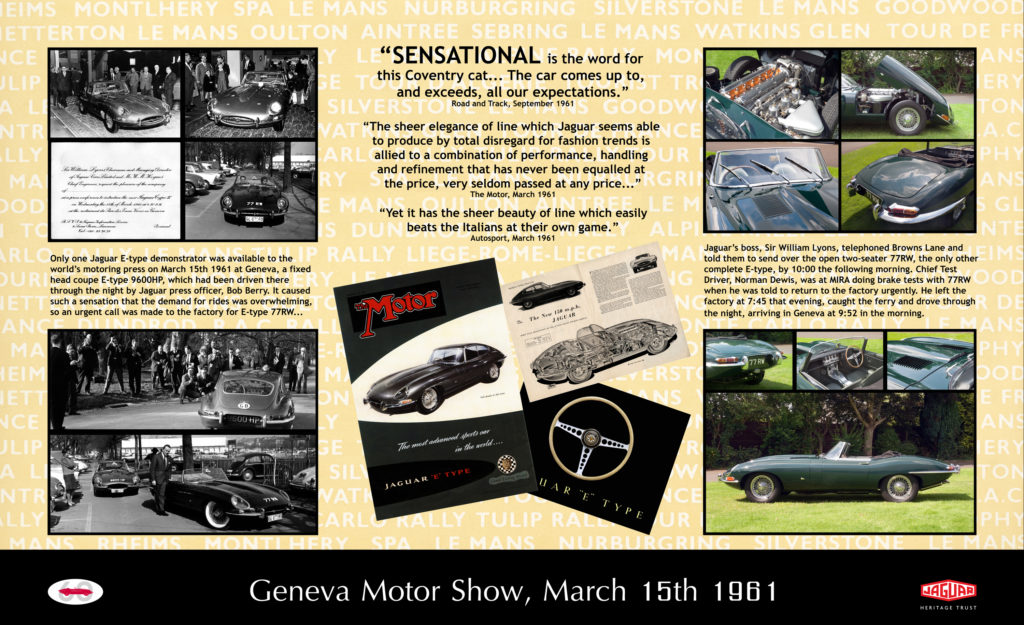
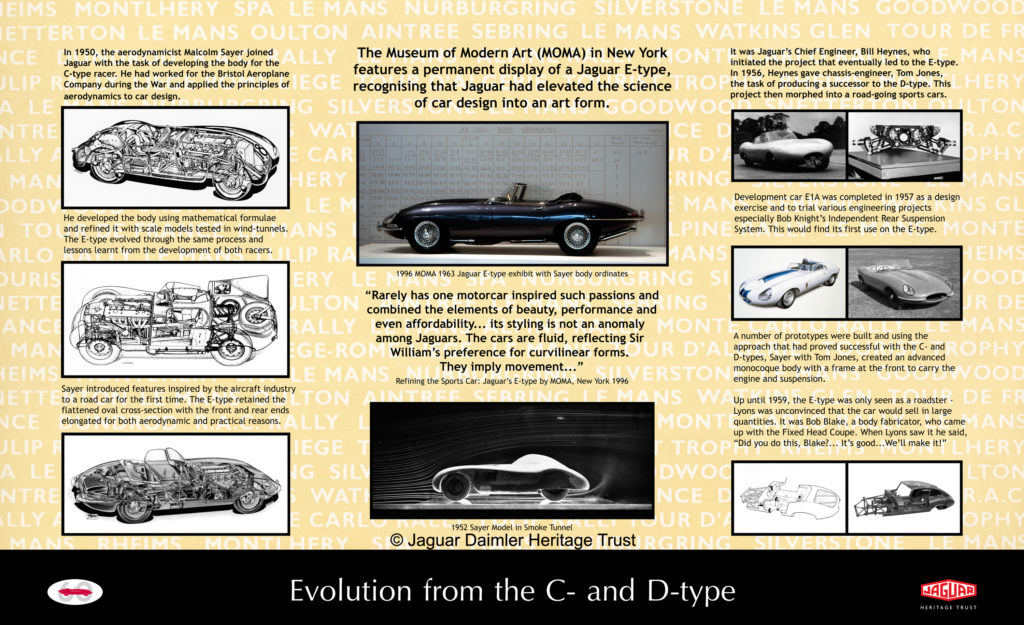
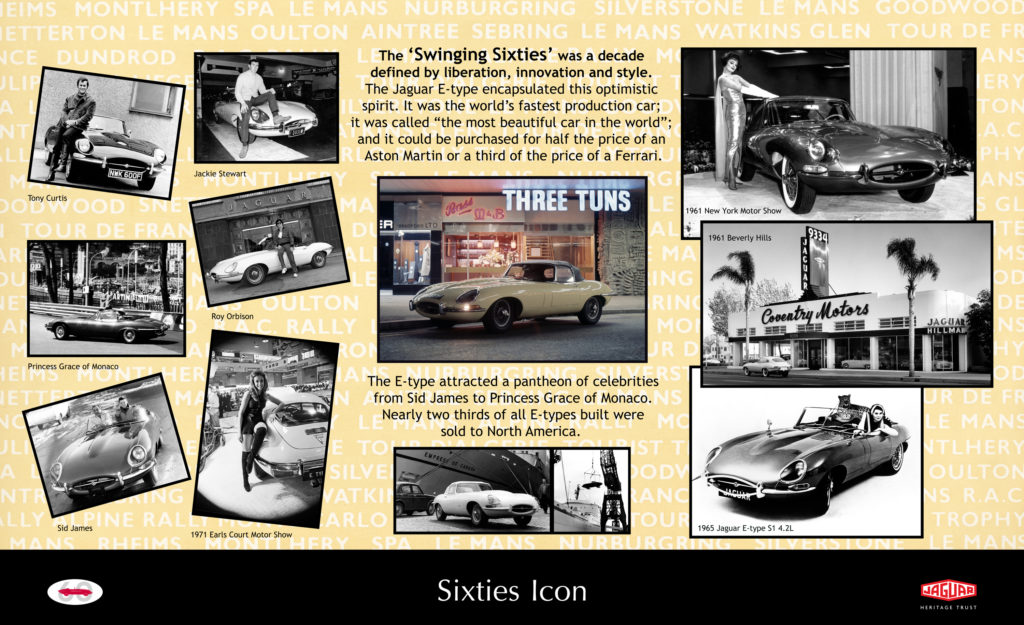
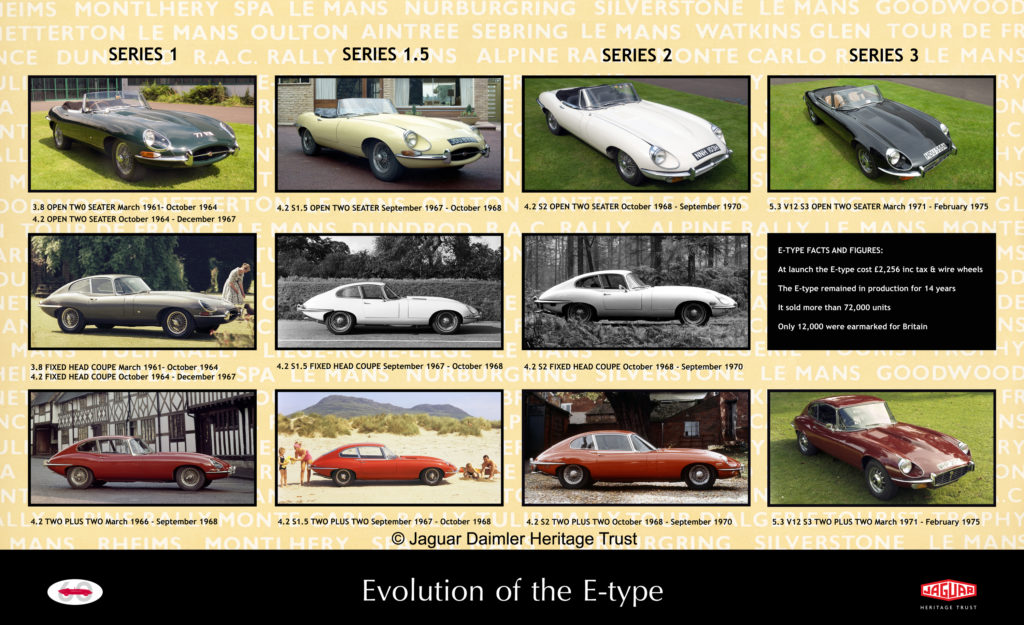
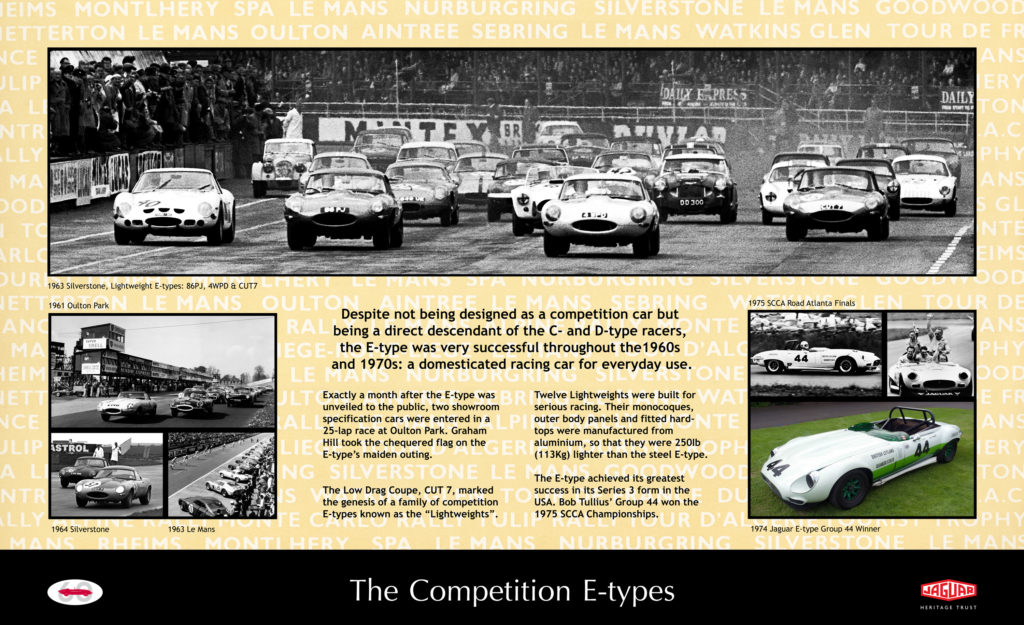
The Cars on Display
We collected an excellent selection of cars for the exhibition, some from our own collection but we were also fortunate to have been allowed to borrow three more cars to help us tell our story.
-
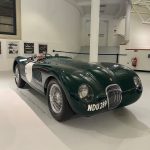
- 1953 C-type, NDU 289
-
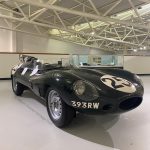
- 1956 D-type, 393 RW
-
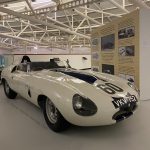
- 1960 Prototype E2A, VKV 752
-
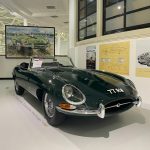
- 1961 E-type, 77 RW
-
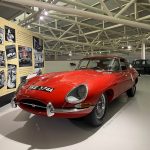
- 1963 E-type, YKE 374A
-
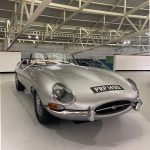
- 1966 E-type, PRP 159D
-
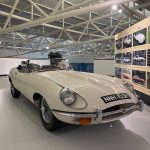
- 1969 E-type, NNH 103H
-
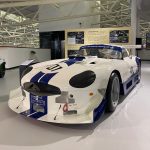
- 1971 The World’s Fastest E-Type
-
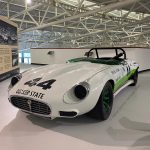
- 1974 Group 44 E-type
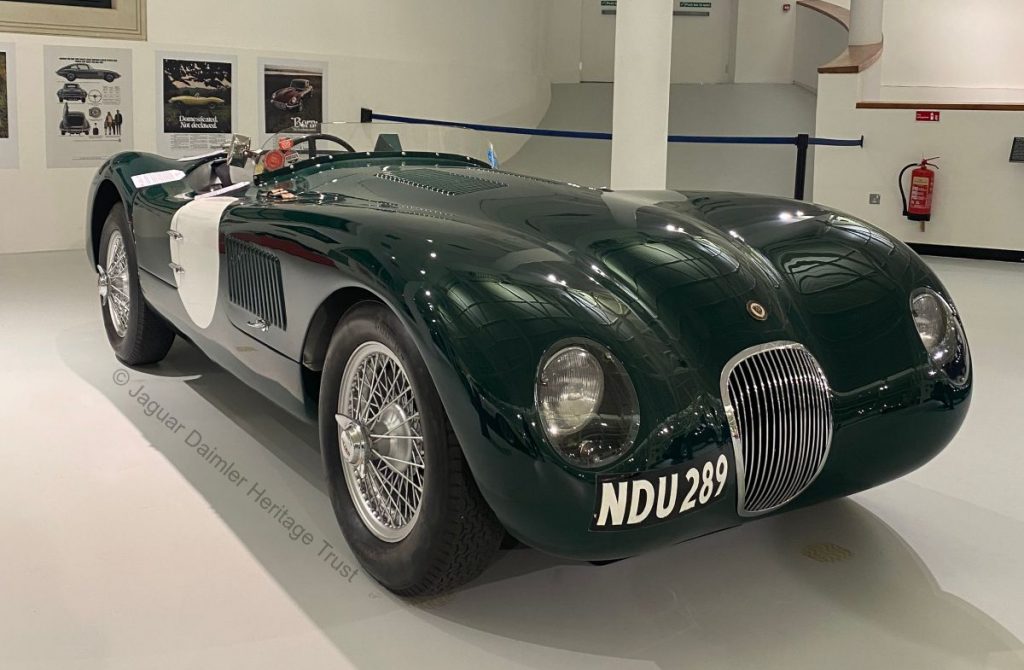
The ‘C’ in the name C-type stands for ‘Competition’ as it was a competition version of the XK120.
The requirement was to reduce weight, improve airflow and reduce air resistance. The traditional steel chassis of the XK120 was replaced by a tubular steel spaceframe for the C-type which held the engine, running gear, etc… This was clothed in Sayer’s lightweight aluminium body – the shape of which he calculated long-hand and refined in wind tunnel testing.
The D-type was an evolution of the C-type both structurally and body-wise.
Instead of a complete steel spaceframe the car was built around a very strong central tub, with a spaceframe holding the engine and gearbox and front suspension. The rear axle and suspension were fixed to the rear bulkhead. The body was clothed with clamshell sections front and rear and the rear fin was developed to improve high speed stability at Le Mans.
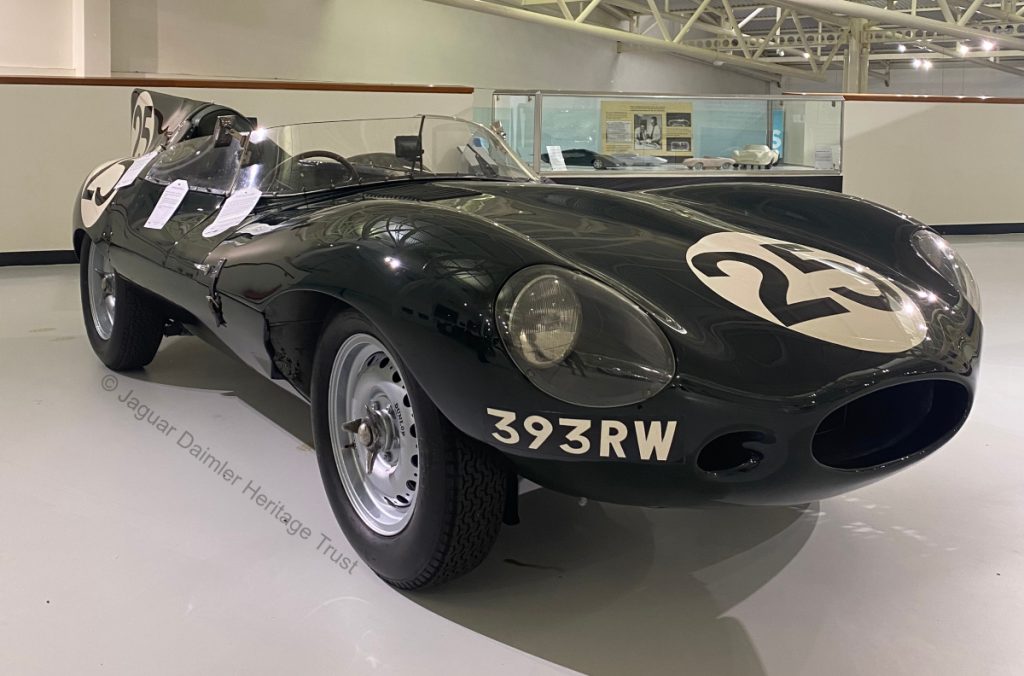
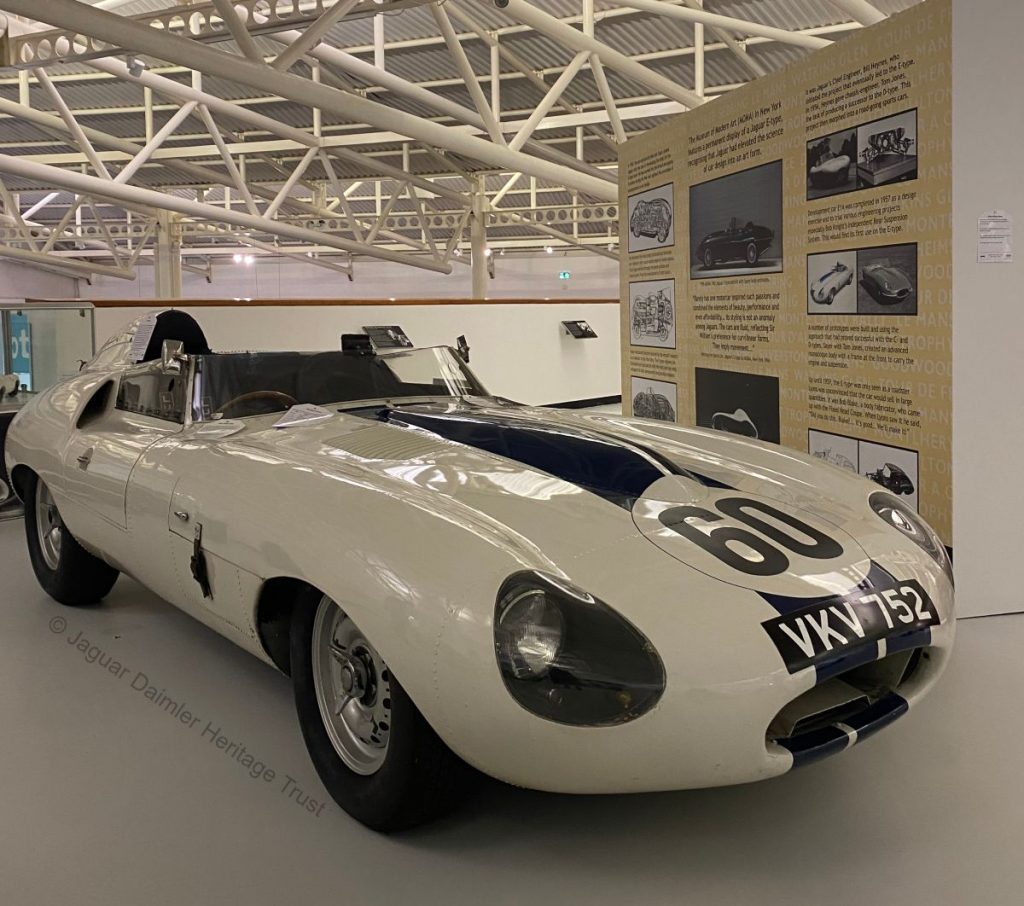
Next to the D-type there was the prototype car, E2A.
Jaguar built two prototypes, more as evolutions of the D-type than specifically part of the E-Type project. E1A was built in 1957 and looks like a three quarter sized E-Type. The E-Type shape was starting to emerge. The central tub was extended to include the rear of the car with Bob Knight’s new Independent Rear Suspension fitted. The car was test driven by Lyons, Heynes and Dewis. It was also loaned to motorist journalist Christopher Jennings for a weekend in Wales who gave Lyons very positive feedback.
E1A was scrapped in 1959 and replaced with E2A which was a much stronger construction with the IRS setup fixed to the body on rubber mounts to remove vibration.
American racing driver Briggs Cunningham, saw E2A and asked Lyons if he could enter it for the 1960 Le Mans race.
It raced in Cunningham’s colours of white with blue stripes, appearing in the entry list as ‘D-type Modified’. It retired with engine problems after 29 laps. Its 3 litre (Le Mans spec) XK engine was swapped for a 3.8 litre one, necessitating the addition of a bonnet bulge which was riveted in place – and came to be an iconic part of the E-Type when launched.
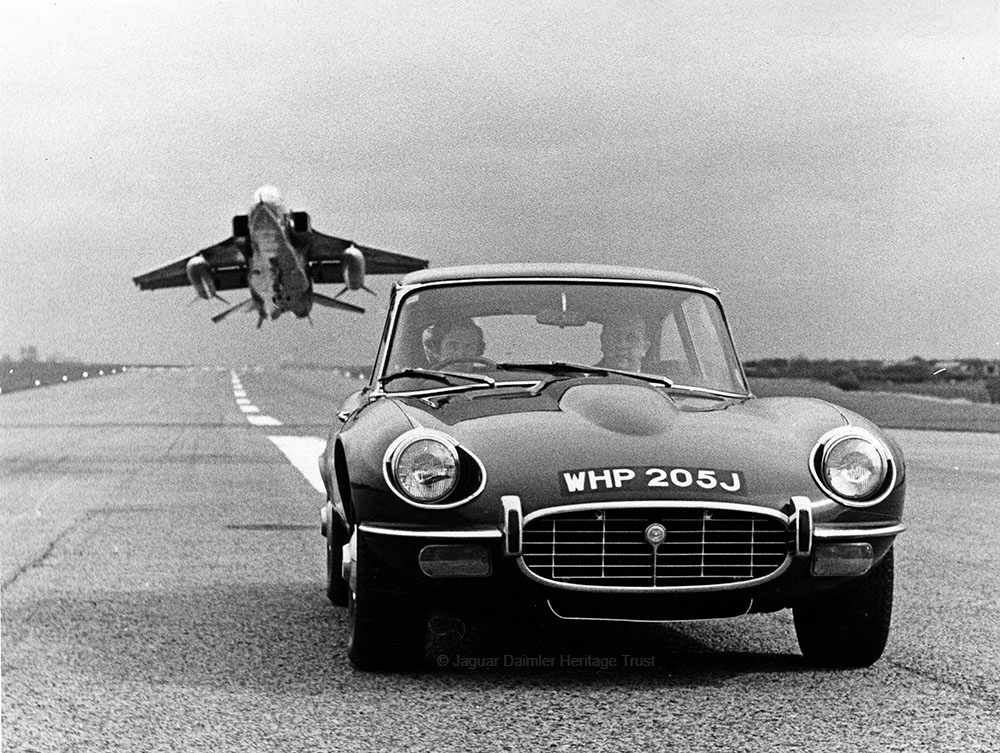
When our E-type WHP 205J was used on a runway for a photoshoot with a Jaguar jet fighter aircraft, the young apprentice driver asked the RAF pilot how close he could get to the roof of the car, ‘how thick is the paint?’ came the pilot’s reply
After some time in the US it returned to Jaguar Cars where it was saved from being destroyed by becoming part of a private museum collection. It is now in the hands of a Swiss collector who loaned us the car for this exhibition.
The red E-Type Fixed Head Coupé from our collection, YKE 374A, takes the evolution to the next stage.
Originally, Lyons’ plan was only to make a roadster version of the E-Type. Sayers’ body calculations were given to metal worker Bob Blake to make up the panels. Having built up the body for the Roadster, Blake turned his attention to making a Fixed Head Coupe. He made another body and worked up the roof, rear wings and rear door. When Lyons saw this he said, ‘I like it, we’ll build it’. The Geneva show car (not included in our exhibition) was built as a Roadster and converted into a Coupe by Bob Blake.
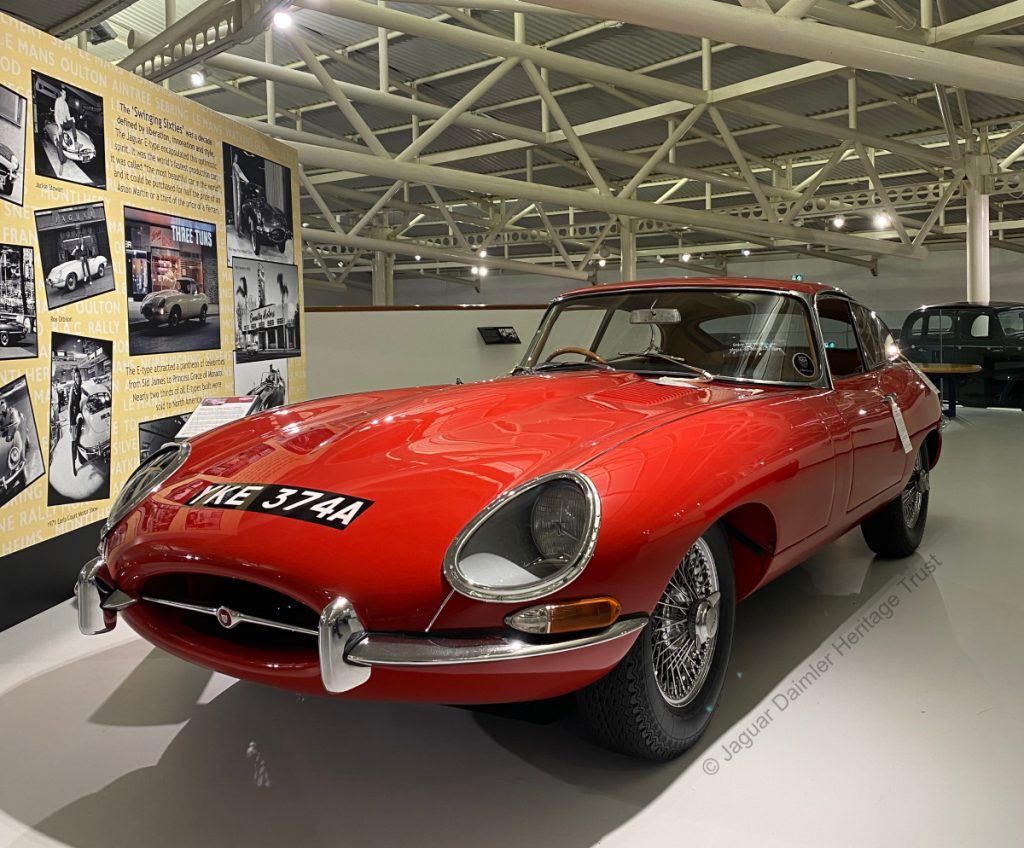
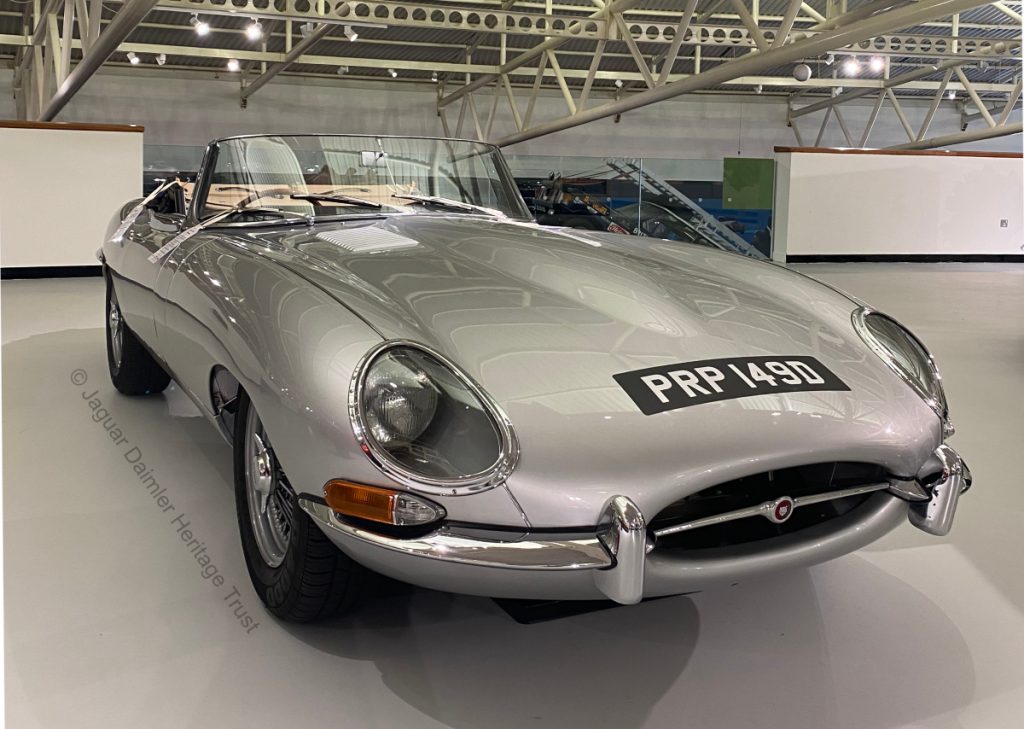
Next to YKE 374A was a 1966 Series 1 E-Type, PRP 149D, which outwardly looks the same as the earlier one but represents the first major upgrade to the car.
The 3.8 litre engine was replaced by a 4.2 litre version, the power remained the same but torque was increased so it pulled better at lower revs. A new Jaguar designed and built gearbox replaced the aged Moss box that had no synchro on first gear. The brakes were uprated and the early, small, bucket seats were replaced with bigger, better, adjustable and more comfortable seats. For many E-Type owners this is the most desirable version as it retains the aesthetic purity of the original with faired-in headlamps and slim sidelamps, and it is a much better car to drive, smoother gear-change, better brakes and extremely comfortable for long distance touring.
Bigger changes were in store for the 1969 models due to the influence of US safety and emissions regulations which came into force on 1 January 1968.
At the front, much larger side lamps and indicators were re-positioned below the bumper and flanked a larger air intake. The rear bumper was raised and new larger tail lamp clusters were fitted below it. Between them was a new number plate plinth with two reversing lamps.
There were also several mechanical changes. More powerful Girling brakes were now fitted, and a cross-flow radiator with two fans and a separate expansion tank was introduced. Power steering became available as an optional extra and altogether, the changes were sufficient for the revised model to be officially called the Series 2 and be given the new chassis number prefix of 1R instead of 1E, with new series of numbers – our 1969 Jaguar E-type, NNH 103H, is an example of this.
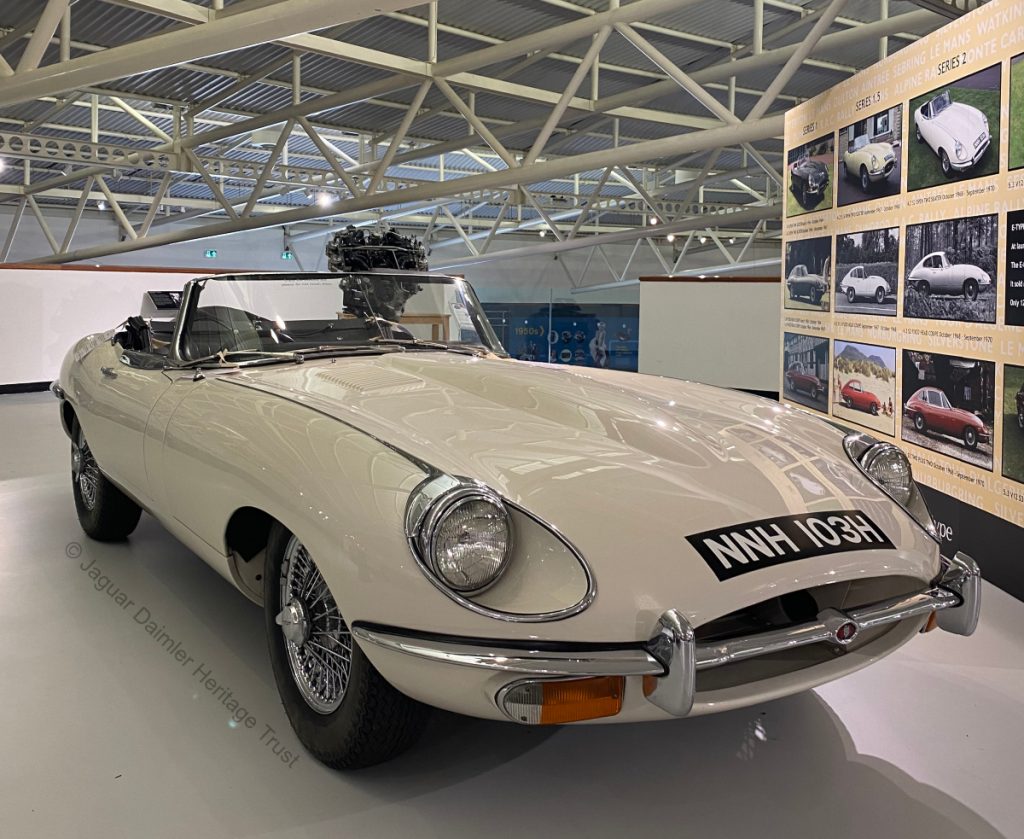
In 1971 Jaguar launched their 5.3 litre V12 engine in the E-Type and it went on to power the large XJ Saloons, XJSes, etc… The 2 seater Coupé version was dropped and only a 2 seater Roadster and the 2+2 Coupé were built, both on the extended floorpan of the 2+2. The Series 3 is the best car for taller drivers as there is much more legroom and headroom in both versions.
In the film ‘The Italian Job’ two E-types were smashed by a digger – an OTS, 848 CRY (850012) and a FHC, 619 DXX (860277). Both cars have been restored and still exist
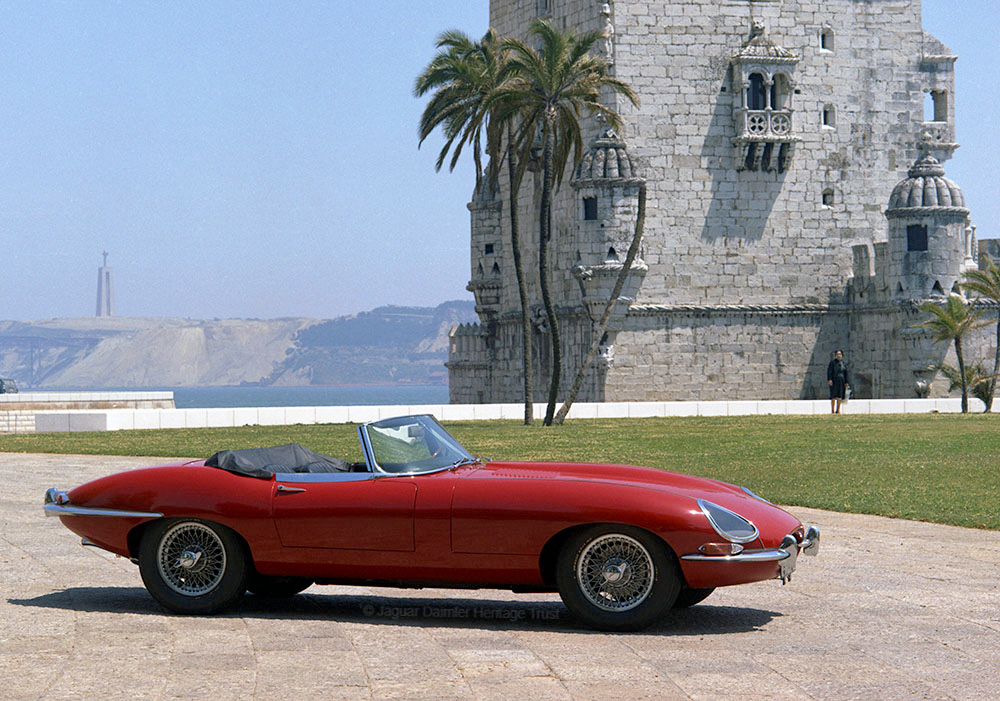
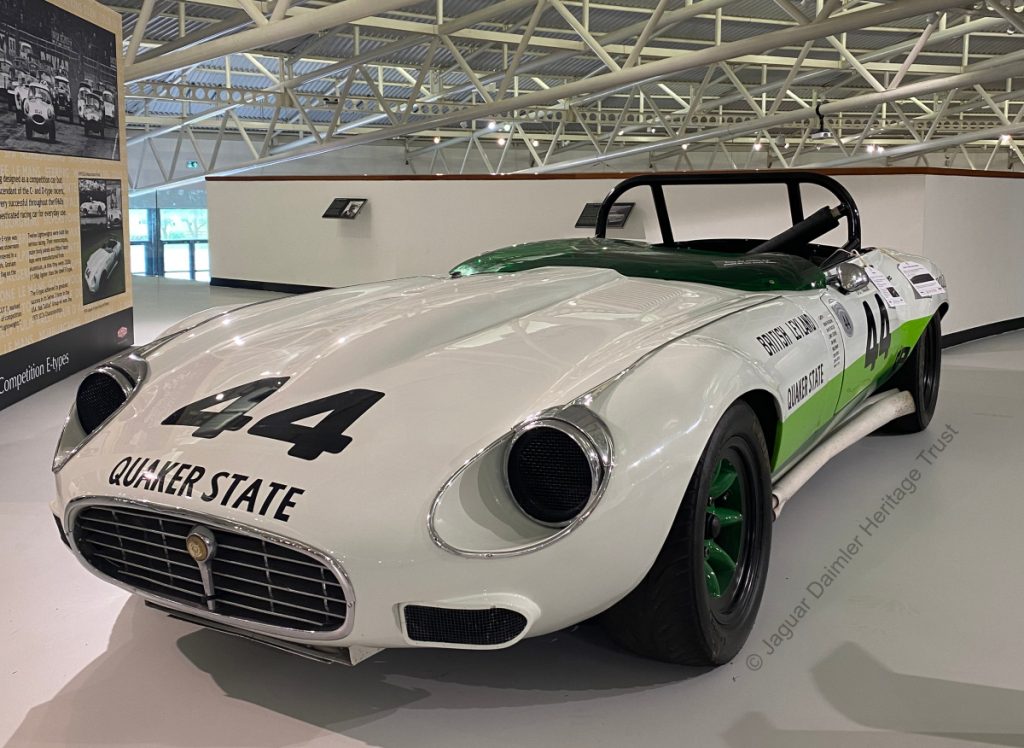
Initially V12 sales in the US were slow so British Leyland (Jaguar’s owners at the time) signed up Bob Tullius to race the V12 E-Types under his Group 44 team banner.
Group 44 had been founded ten years before by Tullius and Brian Fuerstenau, and had an impressive list of race victories, as well as ten national championships to their credit.
The next car on display started life as a standard V12 E-Type and was raced extensively in the 1980s and 1990s in the ‘Modsports’ category.
It evolved over a period of 20 years, with its engine growing in size from 5.3 to 7.3 litres, now fuelled by six, twin-choke webbers. The car has many bespoke parts including suspension and braking system and, helping to deliver the power to the tarmac, it has a rear wing from an XJR9 and a bespoke front splitter.
In the late 1990’s it achieved the title of the ‘World’s Fastest E-type’ and to consolidate this, the car was entered in the 2001 Woodbridge Speed Trials and achieved an E-type speed record of 184 mph (296.12 km/h). It can sprint from a standstill to 150 mph (242 km/h) in around eight seconds.
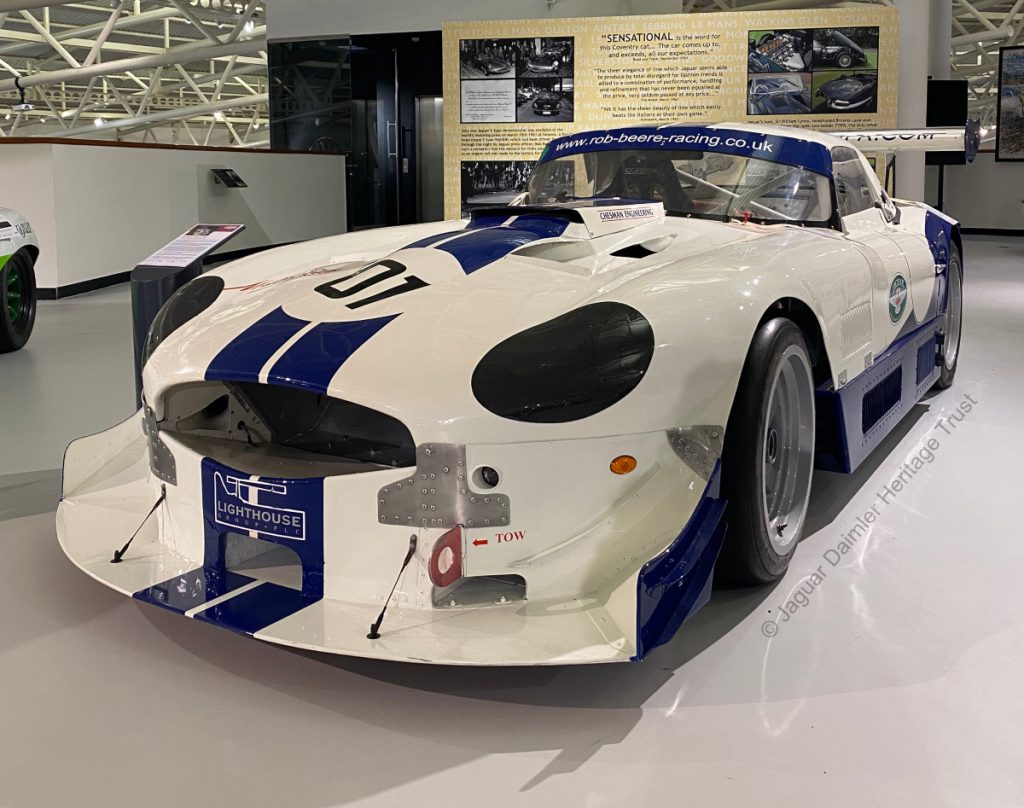
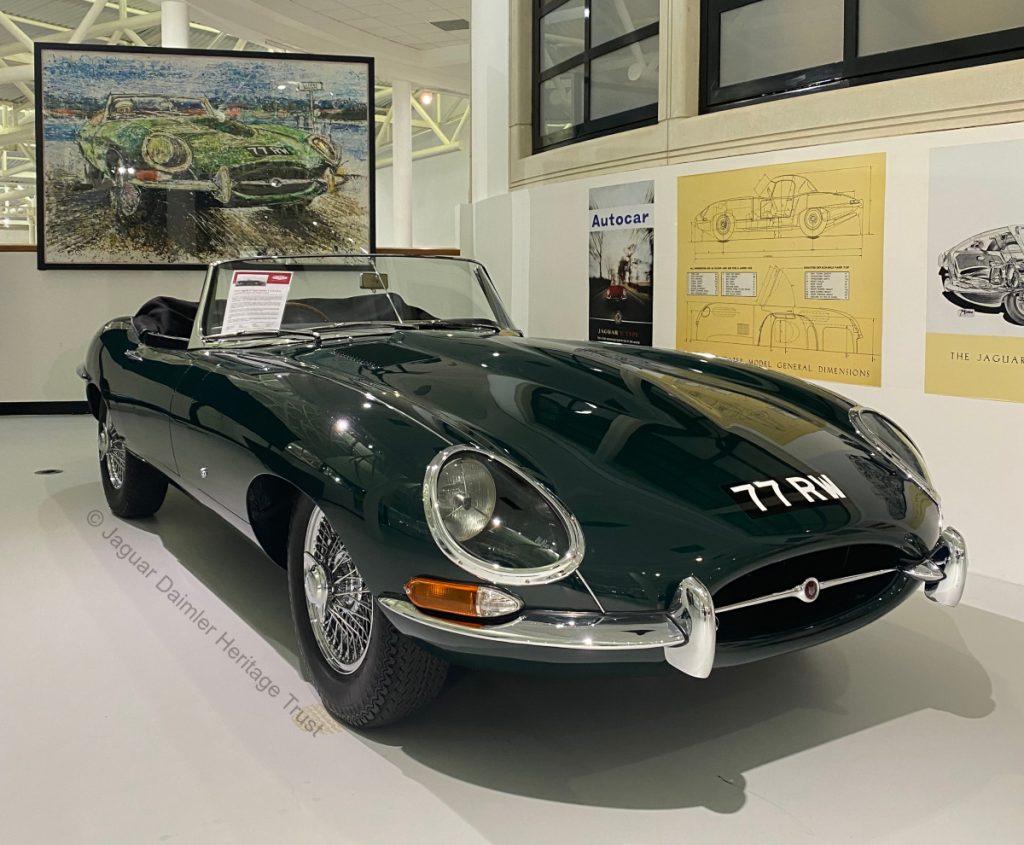
For the 50th anniversary of the launch of the E-type, the Trust commissioned local contemporary artist Ian Cook, aka PopBangColour, to create a unique piece.
In front of a live audience at the Coventry Transport Museum, using radio controlled cars, car tyres and toy car wheels, Ian painted a copy of the famous picture of Dewis in the Jaguar E-type 77 RW.
During the duration of the ‘E-type Evolution’ exhibition, 77 RW wasn’t always on display as it was booked for a few outings, but when it was, it was displayed with the painting.
On our YouTube channel we have a video of Tony Merrygold, our Vehicle Collection Manager, and Paul Walton, editor of Jaguar World, talking about the exhibition:
A more detailed account of the evolution and development of the E-Type can be found in the Jaguar Engineering section of our website should you want to read the story in greater depth.
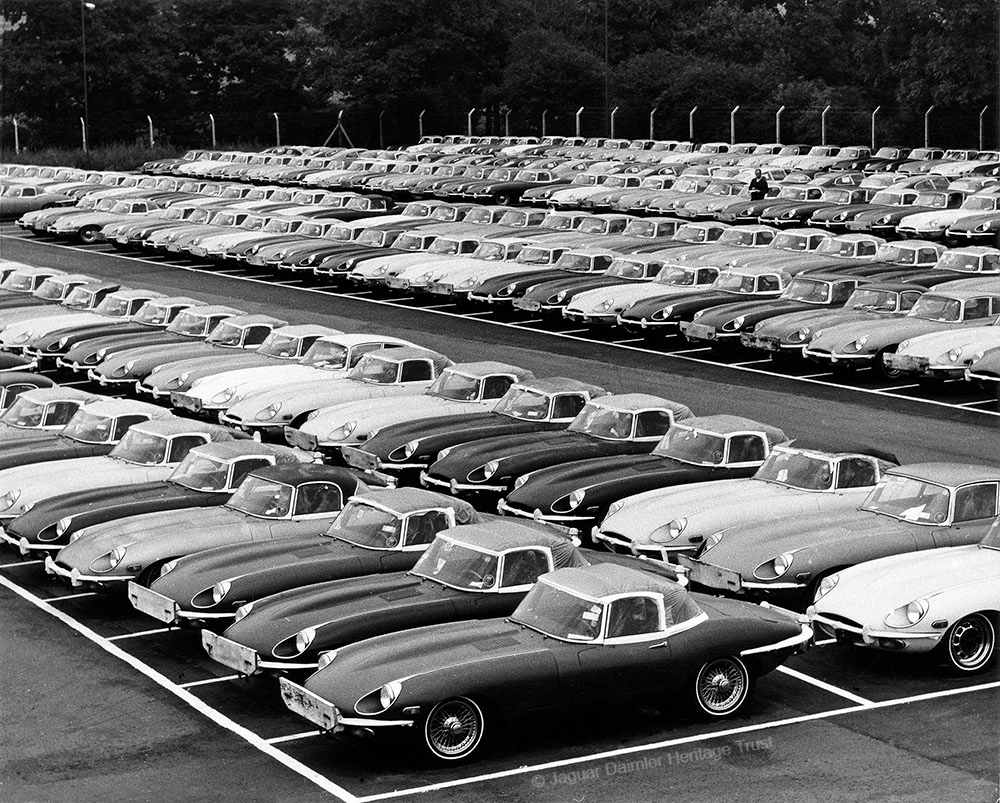
From 1961 to 1974 72,512 E-types were built
We at JDHT collect and preserve the collection of vehicles, both past and present that relate to the history, industrial development and social impact of Jaguar and its associated companies, as well as preserving historical records, artworks and artefacts from our Archive to ensure these are enjoyed for future generations.
A number of these artefacts were on display at the ‘E-type Evolution’ exhibition.
A series of adverts were reproduced on the mezzanine wall area:
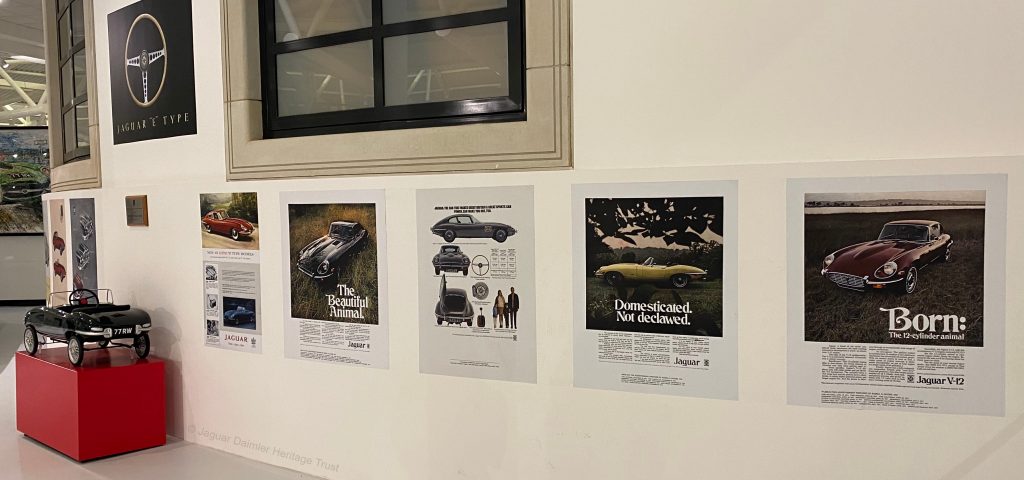
We had a special display explaining the work of aerodynamicist Malcolm Sayer, who was responsible for the body design of the C, D and E-Types.
This display included a number of wind tunnel models. These are 3D printed copies of the original models produced for us by Jaguar Cars.
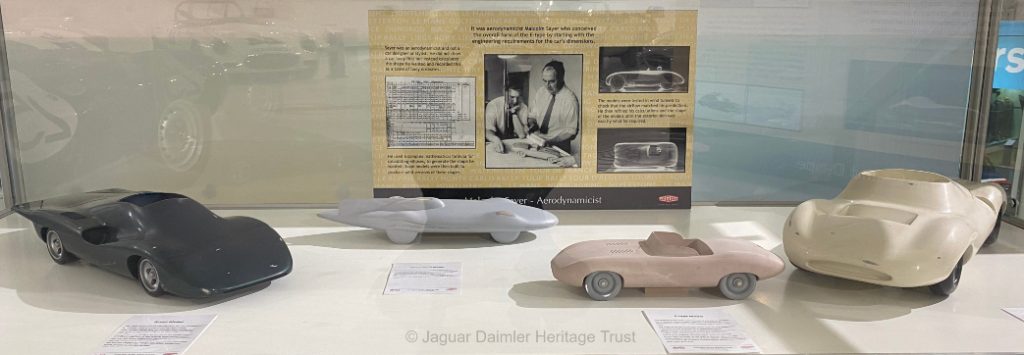
We have recently (6 June 2022) become aware that one of the signs at the E-type Evolution Exhibition called ‘Malcolm Sayer – Aerodynamicist’ contains inaccurate information about the legendary Jaguar designer Malcolm Sayer.
On the sign, it states that Malcolm Sayer was not a car designer and that he did not first draw the body of the vehicle he was designing. This statement is not accurate. Malcolm Sayer worked at Jaguar Cars Ltd as a stylist responsible for the body design of the Jaguar C-type, Jaguar D-type, the Jaguar E-type and the Jaguar XJ13. Malcolm Sayer was not only a trained aerodynamicist but also an artist.
Malcolm Sayer started the design process with basic sketches and drew the shape of the vehicle he was designing (e.g. the Jaguar C-type) full-size on the floor in chalk before making any calculations.
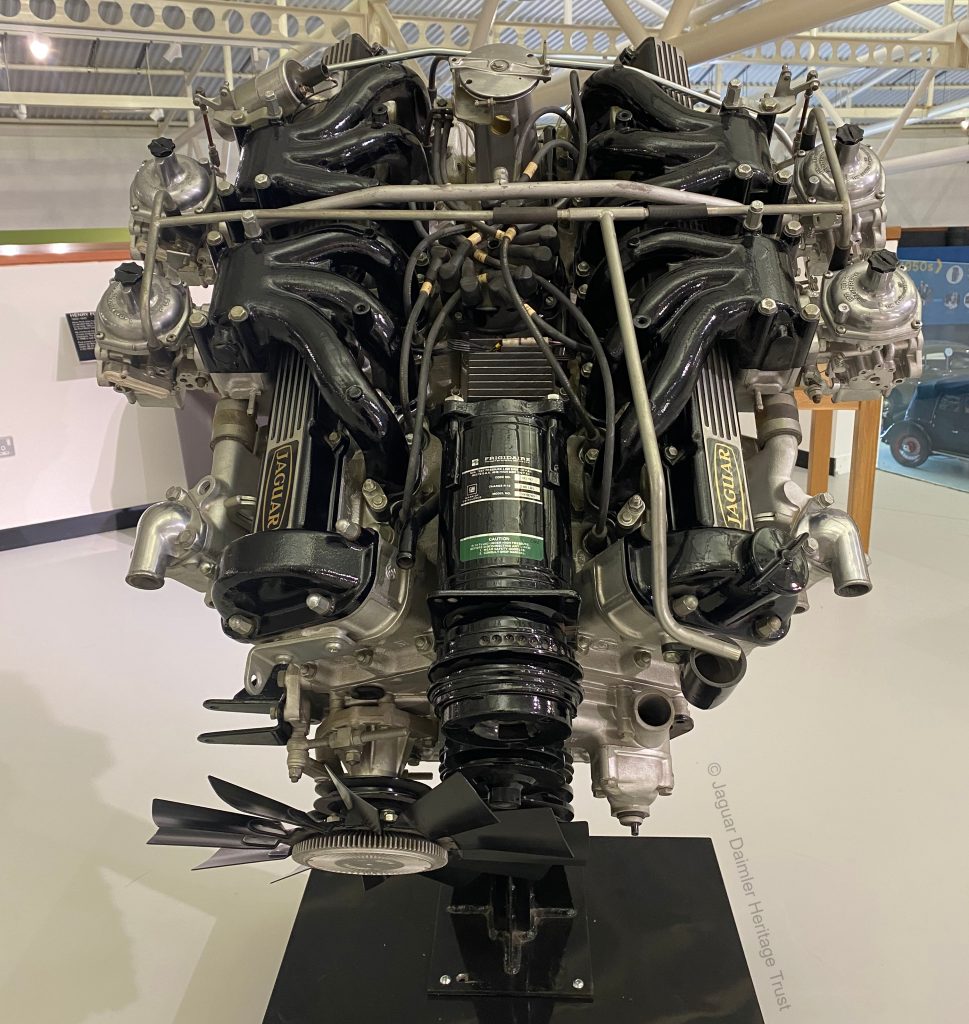
We also had a complete V12 engine on display.
The sectioned V12 engine that the JDHT owns and is normally on display at the Collections Centre, is fuel injected not carburetted.
Fuel injected engines were fitted to the XJ6 saloons and the XJ-S that replaced the E-Type, but never to E-Types. We are grateful to XK Engineering in Shilton for loaning us their display V12 engine which has the correct four Stromberg carburettors fitted. This normally stands in their own reception area welcoming visitors to their site.
Play the below video to watch a quick walk through the exhibition (without the prototype E2A as, when this video was taken, it was returned to its owner):